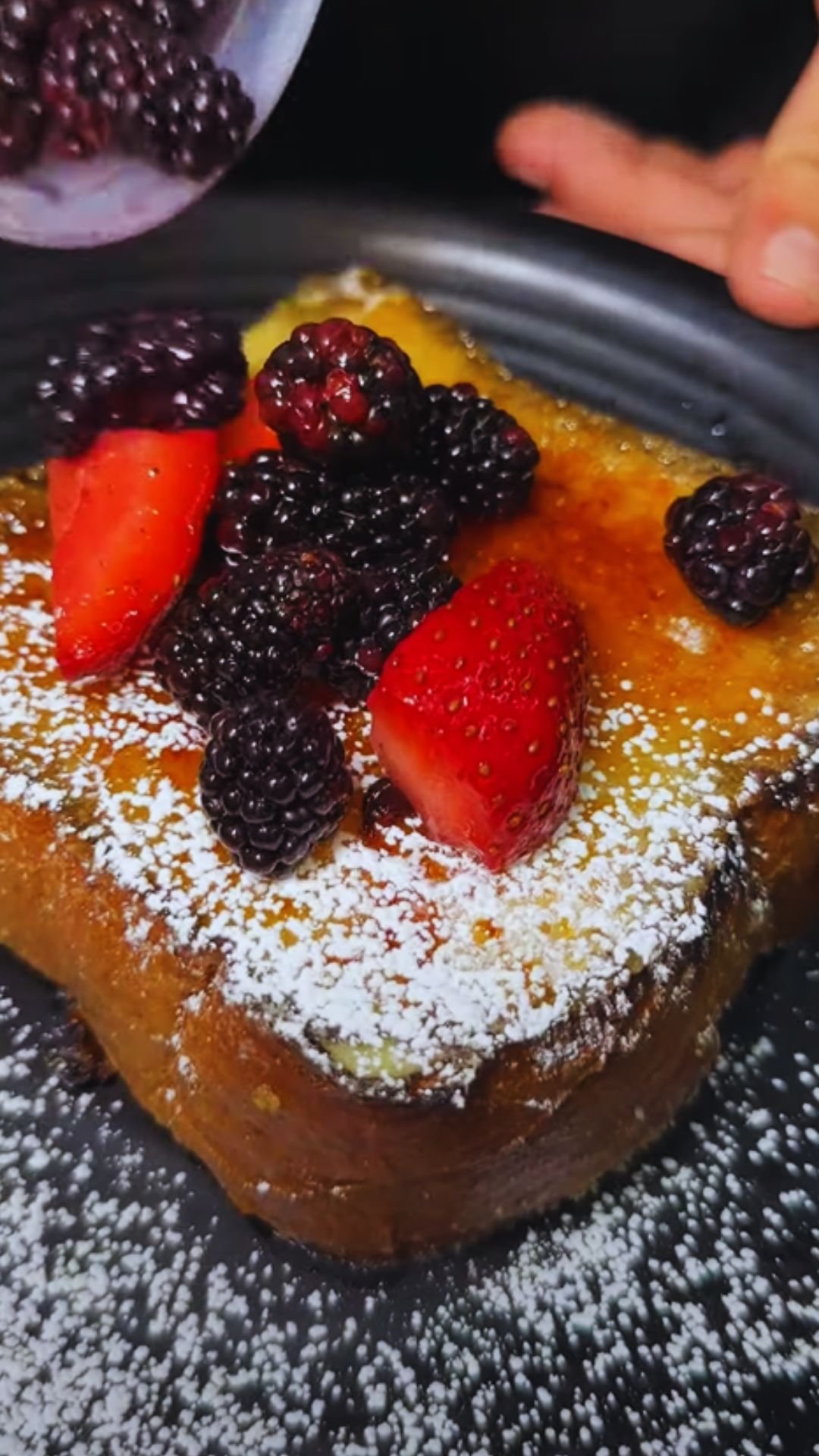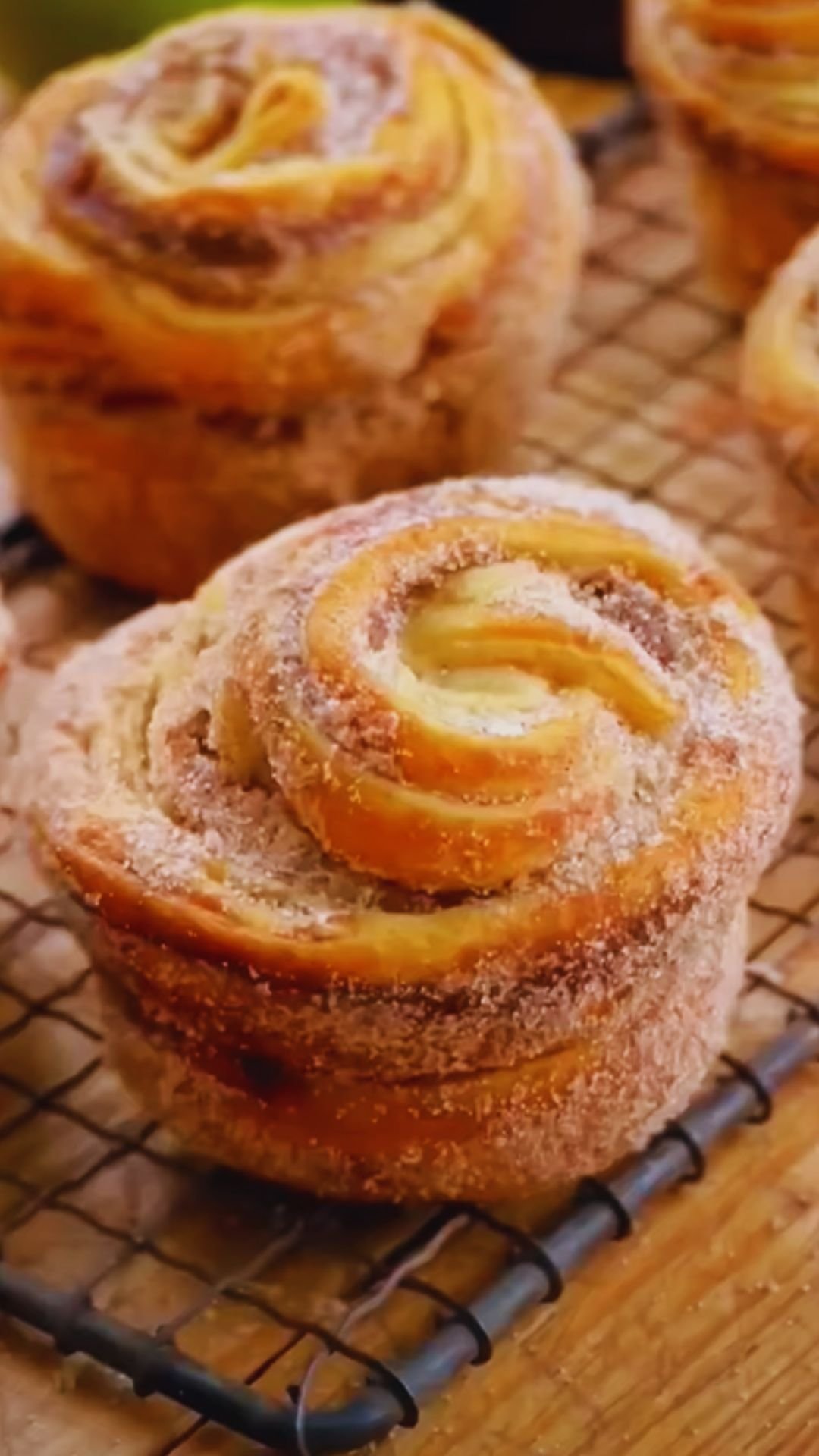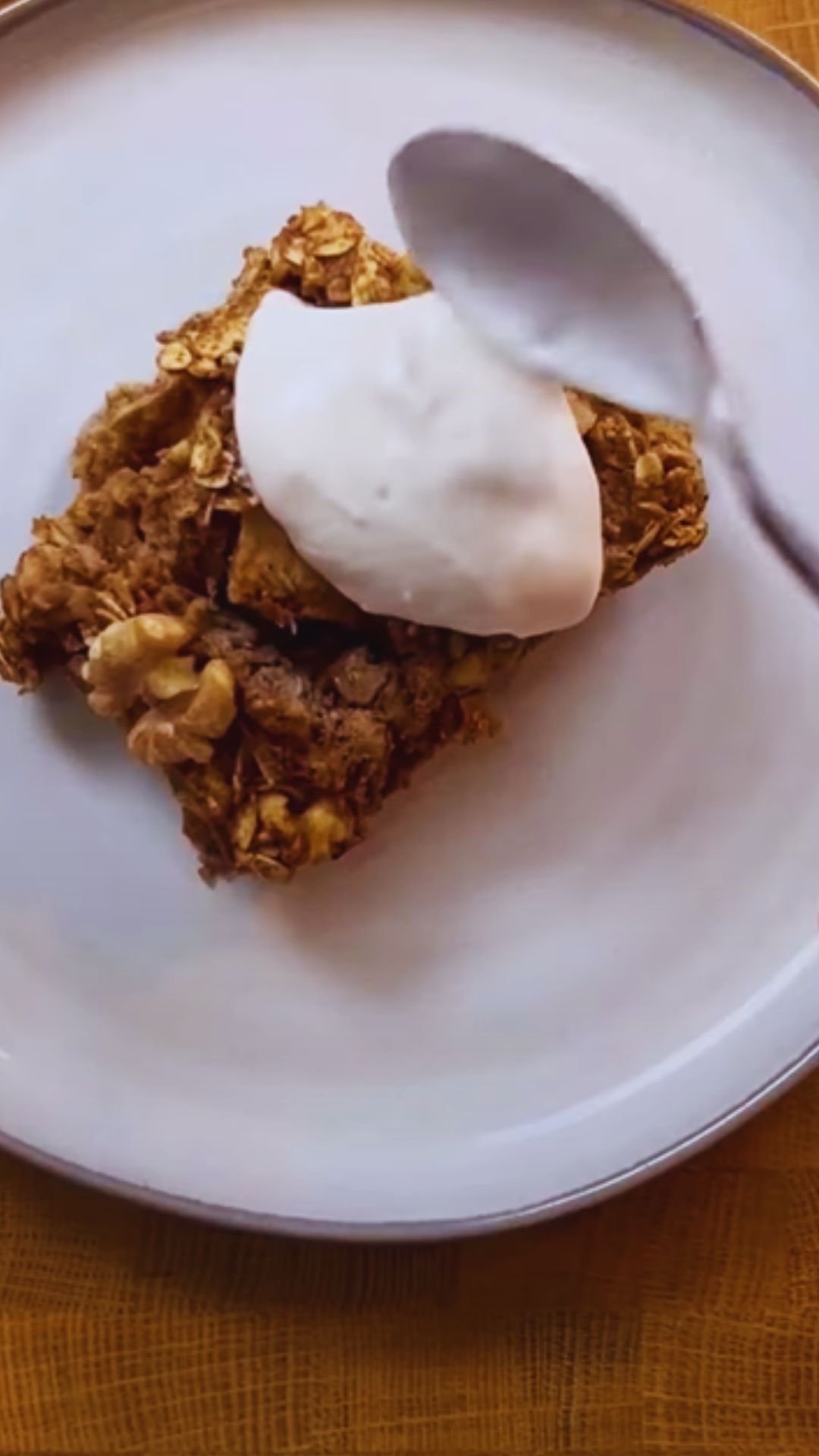I’ve always believed that breakfast deserves to be extraordinary. After years of perfecting my brunch recipes, I’m thrilled to share what has become my signature dish—a decadent Crème Brûlée French Toast topped with homemade salted caramel sauce that transforms an ordinary morning into something magical.
This isn’t just any French toast recipe. By infusing the classic breakfast favorite with the luxurious flavors of crème brûlée—that crackling caramelized sugar top giving way to a custardy, vanilla-scented interior—we’re elevating breakfast to dessert status while keeping it firmly in the realm of acceptable morning fare. The addition of homemade salted caramel sauce takes this dish to heights that will have your family or guests talking for weeks.
The Secret History of French Toast
Before diving into this remarkable recipe, I think it’s worth appreciating the fascinating history behind French toast. Despite its name, this breakfast classic wasn’t actually invented in France. The concept of soaking bread in eggs and milk before cooking dates back to ancient Rome, where it was known as “pan dulcis.” The Romans would soak bread in a milk and egg mixture, fry it, and then top it with honey.
The dish we know today as French toast was actually called “pain perdu” (lost bread) in France, a practical solution for using stale bread that would otherwise be thrown away. By soaking the hardened bread in a custard mixture, it regained moisture and palatability.
In the United States, French toast became popularized in the 18th century by European settlers, and it has since evolved into countless creative variations—including the crème brûlée version I’m sharing today, which combines French toast with another beloved French dessert.
Ingredients: Quality Matters
For a dish this special, ingredient quality makes all the difference. Here’s what you’ll need:
For the French Toast:
- 1 loaf brioche bread (day-old works best), sliced 1½ inches thick
- 6 large eggs (preferably free-range)
- 2 cups heavy cream
- 1 cup whole milk
- ¾ cup granulated sugar
- 2 tablespoons vanilla extract or 1 vanilla bean, split and scraped
- ¼ teaspoon salt
- Zest of 1 orange (optional but recommended)
- 4 tablespoons unsalted butter, for cooking
- ¼ cup granulated sugar (for the brûlée topping)
For the Salted Caramel Sauce:
- 1 cup granulated sugar
- ¼ cup water
- ¾ cup heavy cream, room temperature
- 4 tablespoons unsalted butter, cubed
- 1 teaspoon pure vanilla extract
- 1-1½ teaspoons flaky sea salt (like Maldon)
Optional Garnishes:
- Fresh berries (strawberries, blueberries, raspberries)
- Whipped cream
- Powdered sugar
- Chopped toasted nuts (pecans or walnuts work beautifully)
- Fresh mint leaves
Equipment You’ll Need
Having the right tools on hand will ensure your French toast turns out perfect every time:
- Large shallow baking dish for the custard mixture
- Whisk
- Large non-stick skillet or griddle
- Spatula
- Kitchen torch (for creating the brûlée effect)
- Heavy-bottomed saucepan (for the caramel sauce)
- Wooden spoon or heat-resistant silicone spatula
- Measuring cups and spoons
- Microplane zester (for the orange zest)
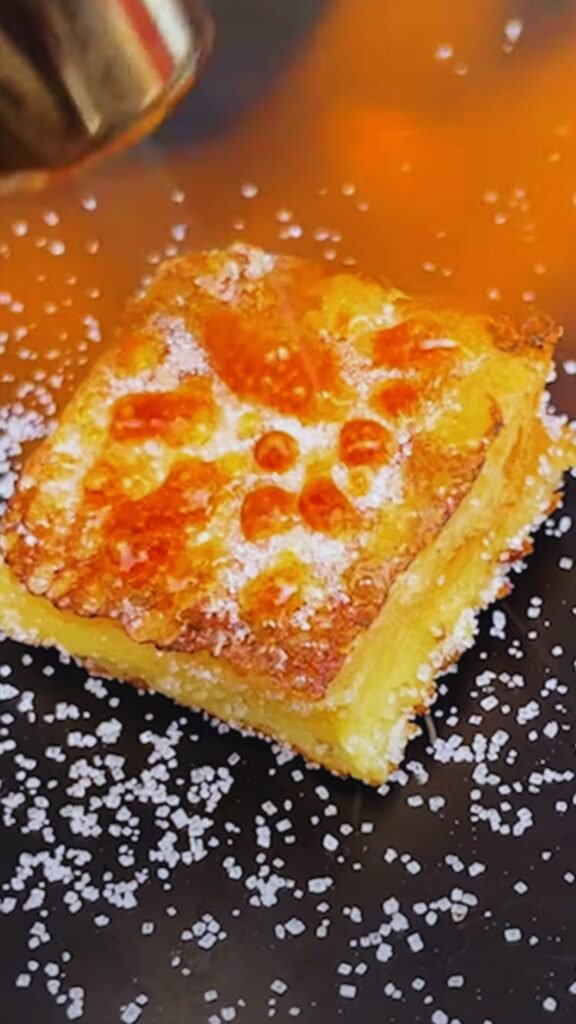
The Preparation: Timing Is Everything
I’ve found that the key to making this dish extraordinary is in the preparation. While it may seem complex, breaking it down into stages makes it manageable and ensures spectacular results.
Stage 1: Custard Preparation (Can Be Done the Night Before)
- In a large bowl, whisk together eggs, heavy cream, milk, sugar, vanilla, salt, and orange zest until well combined.
- Arrange bread slices in a large, shallow baking dish, slightly overlapping if necessary.
- Pour the custard mixture over the bread, making sure all slices are well-coated.
- Cover with plastic wrap and refrigerate for at least 4 hours, or preferably overnight. This allows the bread to fully absorb the custard mixture.
- Halfway through the soaking time, carefully flip the bread slices to ensure even absorption.
Stage 2: Making the Salted Caramel Sauce
Creating homemade caramel sauce might seem intimidating, but I promise it’s worth the effort. The depth of flavor simply can’t be matched by store-bought alternatives.
- In a heavy-bottomed saucepan, combine sugar and water, stirring just until sugar is moistened.
- Heat over medium-high heat without stirring (important!). Swirl the pan occasionally if needed.
- Watch carefully as the mixture turns from clear to golden amber (about 8-10 minutes). This happens quickly, so don’t walk away!
- Once the caramel reaches a deep amber color, remove from heat immediately.
- Carefully and slowly add the room temperature heavy cream (caution: it will bubble vigorously).
- When the bubbling subsides, add butter and whisk until smooth.
- Stir in vanilla and sea salt to taste.
- Let cool slightly. The sauce will thicken as it cools.
Tip: The caramel sauce can be made up to 1 week ahead and stored refrigerated in an airtight container. Gently reheat before serving.
Stage 3: Cooking the French Toast
- Remove soaked bread from refrigerator and let stand at room temperature for 10 minutes.
- Heat a large non-stick skillet or griddle over medium heat.
- Add 1 tablespoon of butter and let it melt.
- Carefully transfer 2-3 slices of soaked bread to the skillet (don’t overcrowd).
- Cook until golden brown and caramelized on the bottom, about 4-5 minutes.
- Flip and cook the other side until golden and the center is cooked through but still custardy, about 3-4 minutes more.
- Transfer to a serving plate and repeat with remaining slices, adding more butter to the pan as needed.
Stage 4: Creating the Brûlée Effect
This is where the magic happens—transforming French toast into crème brûlée:
- Sprinkle each slice of cooked French toast evenly with a thin layer of granulated sugar (about 1-2 teaspoons per slice).
- Using a kitchen torch, carefully caramelize the sugar until it bubbles and turns amber, moving the flame constantly to avoid burning.
- Let the caramelized sugar cool and harden for about 1 minute.
No torch? Alternative method: Place sugared French toast under a preheated broiler for 1-2 minutes, watching carefully to prevent burning.
Stage 5: Assembly and Serving
- Place one or two slices of the brûléed French toast on each plate.
- Drizzle generously with warm salted caramel sauce.
- Add your chosen garnishes: fresh berries, a dollop of whipped cream, a light dusting of powdered sugar, or chopped nuts.
- Serve immediately while the sugar topping is still crisp and the toast is warm.
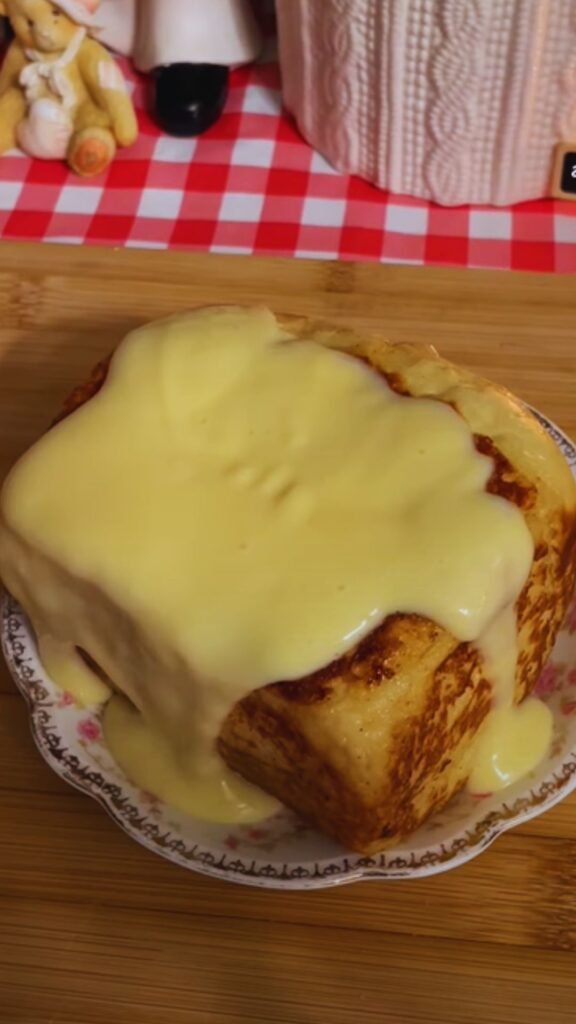
Detailed Nutritional Information
For those keeping track of nutritional content, here’s a breakdown per serving (based on 2 slices):
| Nutrient | Amount | % Daily Value* |
|---|---|---|
| Calories | 650 | – |
| Total Fat | 38g | 49% |
| Saturated Fat | 22g | 110% |
| Cholesterol | 285mg | 95% |
| Sodium | 410mg | 18% |
| Total Carbohydrate | 65g | 24% |
| Dietary Fiber | 2g | 7% |
| Total Sugars | 42g | – |
| Protein | 12g | 24% |
| Vitamin D | 2.2mcg | 11% |
| Calcium | 180mg | 14% |
| Iron | 2.5mg | 14% |
| Potassium | 245mg | 5% |
*Percent Daily Values are based on a 2,000 calorie diet. Your daily values may be higher or lower depending on your calorie needs.
Potential Dietary Modifications
I understand that dietary restrictions shouldn’t prevent anyone from enjoying this decadent dish. Here are some thoughtful modifications:
Gluten-Free Version
Replace brioche with thick-cut gluten-free bread or challah. Ensure all other ingredients are certified gluten-free.
Dairy-Free Alternative
Substitute heavy cream and milk with full-fat coconut milk and coconut cream. Use plant-based butter and adjust the caramel sauce recipe accordingly.
Reduced Sugar Option
Decrease sugar in the custard mixture to ½ cup and use a sugar substitute suitable for caramelizing (like allulose). Note that the texture and flavor profile will be slightly different.
Serving Suggestions
This Crème Brûlée French Toast is a showstopper on its own, but here are some pairing suggestions for a complete brunch experience:
- Fresh seasonal fruit platter
- Crispy bacon or breakfast sausage for a sweet-savory contrast
- Freshly squeezed orange juice
- Hot coffee or espresso
- Sparkling water with a twist of citrus
- Hot chocolate for an extra indulgent morning
- Ginger tea, which complements the caramel notes beautifully
Troubleshooting Common Issues
Even experienced cooks can encounter challenges. Here are solutions to common problems:
| Issue | Possible Cause | Solution |
|---|---|---|
| Soggy center | Bread slices too thick or undercooked | Cut bread to recommended thickness; cook longer over lower heat |
| Burnt exterior, raw interior | Heat too high | Lower heat and cook more slowly to allow center to cook through |
| Caramel sauce crystallizing | Sugar crystals on sides of pan; stirring during cooking | Brush sides of pan with water; avoid stirring once cooking begins |
| Caramel sauce too thin | Not cooked long enough or too much cream added | Cook longer to reduce or add less cream initially |
| Sugar topping won’t caramelize properly | Uneven sugar application or too much moisture | Ensure sugar layer is thin and even; pat bread dry before applying sugar |
| French toast sticking to pan | Pan not hot enough when adding bread or not enough butter | Preheat pan properly; add sufficient butter |
Make-Ahead and Storage Tips
One of the beauties of this recipe is how much can be prepared in advance:
Make-Ahead Options:
- Custard mixture: Can be prepared and refrigerated for up to 2 days.
- Soaked bread: Best when soaked overnight, but can be kept refrigerated for up to 24 hours.
- Caramel sauce: Stays fresh in an airtight container in the refrigerator for up to 2 weeks. Reheat gently before serving.
- Cooked French toast (without brûlée topping): Can be made up to 2 hours ahead and kept warm in a 200°F oven.
Storage and Reheating:
- Leftovers: Store in an airtight container in the refrigerator for up to 2 days.
- Reheating: Warm in a 325°F oven for 10-15 minutes. Note that the caramelized sugar topping will lose its crispness after storage.
- Freezing: Not recommended, as the texture will be compromised.
The Science Behind Perfect French Toast
Understanding the science helps achieve perfect results every time:
- Bread choice matters: Brioche contains more butter and eggs than standard bread, creating a richer base that can stand up to the heavy custard.
- Day-old bread is optimal: Slightly dried bread absorbs more custard without falling apart.
- Custard ratio: The ideal egg-to-dairy ratio ensures a custardy interior that isn’t too eggy or too soggy.
- Sugar caramelization: The brûlée topping undergoes the Maillard reaction, creating complex flavors as the sugars break down under heat.
- Resting period: Allowing the soaked bread to stand briefly at room temperature before cooking ensures even cooking from edge to center.

Seasonal Variations
I love adapting this recipe throughout the year to showcase seasonal ingredients:
Spring
Add a tablespoon of lavender buds to the custard mixture and garnish with fresh strawberries and edible flowers.
Summer
Incorporate lemon zest instead of orange in the custard and top with a mixed berry compote.
Fall
Add ½ teaspoon of cinnamon and ¼ teaspoon of nutmeg to the custard mixture. Serve with sautéed apples or pears.
Winter
Include a tablespoon of orange liqueur in the custard and serve with cranberry compote or candied citrus.
Frequently Asked Questions
Q: Can I use regular sandwich bread for this recipe?
While you technically could use regular sandwich bread, I don’t recommend it. The texture and flavor won’t be the same. Brioche, challah, or thick-cut French bread provides the structure needed to support the custard without falling apart. If you must substitute, choose the thickest, densest bread available.
Q: Is a kitchen torch necessary?
A kitchen torch gives you the most control when caramelizing the sugar topping, resulting in that perfect crème brûlée crack. However, you can use your oven’s broiler as an alternative. Place the sugared French toast on a baking sheet, position it about 4 inches from the broiler element, and watch carefully—it caramelizes quickly!
Q: My caramel sauce seized up when I added the cream. What went wrong?
This usually happens when the cream is too cold or added too quickly. Ensure your cream is at room temperature before adding it to the hot caramel, and pour it in slowly while whisking continuously. If it does seize, keep whisking over low heat until smooth again.
Q: Can I make this recipe for a large group?
Absolutely! You can double or triple the recipe. For serving a crowd, complete steps through cooking the French toast, then keep slices warm in a 200°F oven. Just before serving, add the sugar topping and torch in batches.
Q: How do I know when my caramel has reached the right color?
The perfect caramel will be a deep amber color—think the color of an old penny. Too light, and it will lack flavor complexity; too dark, and it will taste bitter. I recommend practicing with smaller batches if you’re new to caramel-making.
Q: My French toast is too soggy in the middle. What am I doing wrong?
This usually indicates either that your bread slices are too thick or that you’re cooking at too high a temperature. The outside gets done before the inside has a chance to cook through. Try cutting your bread slightly thinner (aim for 1¼ inches instead of 1½) and cooking at a slightly lower temperature for a longer time.
Final Thoughts: Why This Recipe Works
I’ve shared this Crème Brûlée French Toast at countless brunches, and it never fails to impress. What makes it so special is the perfect balance of textures—the crisp caramelized topping giving way to the custardy interior of the French toast, all complemented by the silky salted caramel sauce.
The overnight soaking method not only saves time on the morning of serving but also ensures that every bite is infused with the rich vanilla custard. The addition of salted caramel brings a sophisticated edge that elevates this from a simple breakfast to a gourmet experience.
Whether you’re hosting a special brunch, celebrating a holiday morning, or simply want to make an ordinary weekend extraordinary, this French toast creation is guaranteed to create memorable moments around your table. The combination of familiar comfort food with elegant dessert elements makes it both approachable and impressive—truly the best of both worlds.
What I love most about cooking is how it brings people together, creating moments of joy and connection through shared experiences. This recipe, more than most, seems to have that magical quality of making time slow down while everyone savors each bite. I hope it brings the same pleasure to your table as it has to mine over the years.
